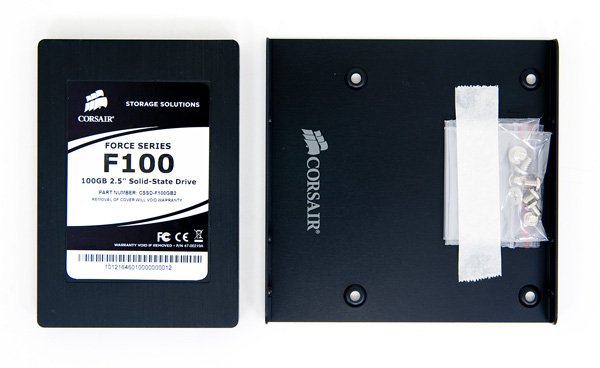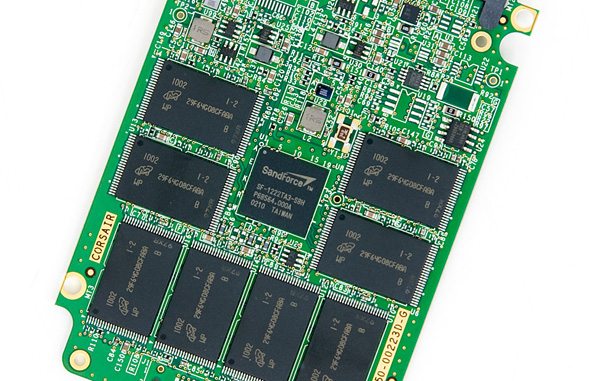Corsair's Force SSD Reviewed: SF-1200 is Very Good
by Anand Lal Shimpi on April 14, 2010 2:27 AM ESTUpdate: Random write performance of the drive we reviewed may change with future firmware updates. Click here to find out more.
Corsair’s late entry into the SSD market meant that it missed the JMicron mess of the early days, but it also meant that Corsair missed the bulk of the early Indilinx boat. Not interested in making the same mistake twice, Corsair took the same risk as many other SSD makers and got in bed with a little company called SandForce.
Widely believed to be the creator of the technology behind Seagate’s first SSD, SandForce has been popping up all over the place lately. We first encountered the company late last year with a preview of OCZ’s Vertex 2 Pro. SandForce's technology seemed promising.
The problem of maintaining SSD performance is a lot like keeping a room tidy and clean. If you make sure to put things in the right place the first time and don’t let dirt accumulate, you’ll end up with an organized, pristine looking room. However if you just throw your stuff around and let stains go untouched, you’ll spend a lot more time looking for things and probably end up ruining the place.
The same holds true for SSDs. If the controller doesn’t properly place data it’ll take longer to place new data. And if the controller doesn’t properly wear level, you’ll end up reducing the life of the drive.
I’ve explained the how behind all of this countless times before, so I’ll spare you the details here. Needless to say, it’s a juggling act. One that requires a fast enough controller, a large amount of fast storage (whether it is on-die cache or off-chip DRAM) and a good algorithm for managing all the data that gets thrown at it.
At a high level Crucial/Micron, Indilinx and Intel take a relatively similar approach to the problem. They do the best with the data they’re given. Some do better than others, but they ultimately take the data you write to the drive and try to make the best decisions as to where to put it.
SandForce takes a different approach. Instead of worrying about where to place a lot of data, it looks at ways to reduce the amount of data being written. Using a combination of techniques akin to lossless data compression and data deduplication, SandForce’s controllers attempt to write less to the NAND than their competitors. By writing less, the amount of management and juggling you have to do goes down tremendously. SandForce calls this its DuraWrite technology.

DuraWrite isn’t perfect. If you write a lot of highly compressed or purely random data, the algorithms won’t be able to do much to reduce the amount of data you write. For most desktop uses, this shouldn’t be a problem however.
Despite the obvious achilles’ heel, SandForce’s technology was originally designed for use in the enterprise market. This lends credibility to the theory that SandForce was Seagate’s partner of choice for Pulsar. With enterprise roots, SandForce’s controllers and firmware are designed to support larger-than-normal amounts of spare area. As you may remember from our earlier articles, there’s a correlation between the amount of spare area you give a dynamic controller and overall performance. You obviously lose usable capacity, but it helps keep performance high. SandForce indicates that eventually we’ll see cheaper consumer drives with less NAND set aside as spare area, but for now a 128GB SandForce drive only gives you around 93GB of actual storage space.
Introducing the SF-1200
The long winded recap brings us to our new friend. The Vertex 2 Pro I previewed last year used a full fledged SF-1500 implementation, complete with ridiculously expensive supercap on board. SandForce indicated that the SF-1200 would be more reasonably priced, at the expense of a performance hit. In between the two was what we got with OCZ’s Vertex Limited Edition. OCZ scored a limited supply of early controllers that didn’t have the full SF-1500 feature set, but were supposedly better than the SF-1200.

Today we have Corsair’s Force drive, its new performance flagship based on the SF-1200. Here’s what SandForce lists as the differences between the SF-1500 and SF-1200:
| SandForce Controller Comparison | ||||
| SF-1200 | SF-1500 | |||
| Flash Memory Support | MLC | MLC or SLC | ||
| Power Consumption | 550 mW (typical) | 950 mW (typical) | ||
| Sequential Read/Write Performance (128KB) | 260 MB/s | 260 MB/s | ||
| Random Read/Write Performance (4K) | 30K/10K IOPS | 30K/30K IOPS | ||
| Security | 128-bit AES Data Encryption, Optional Disk Password | 128-bit AES Data Encryption, User Selectable Encryption Key | ||
| Unrecoverable Read Errors | Less than 1 sector per 1016 bits read | Less than 1 sector per 1017 bits read | ||
| MTTF | 2,000,000 operating hours | 10,000,000 operating hours | ||
| Reliability | 5 year customer life cycle | 5 year enterprise life cycle | ||
The Mean Time To Failure numbers are absurd. We’re talking about the difference between 228 years and over 1100 years. I’d say any number that outlasts the potential mean time to failure of our current society is pretty worthless. Both the SF-1200 and SF-1500 are rated for 5 year useful lifespans, the difference is that SandForce says the SF-1200 can last for 5 years under a "customer" workload vs. an enterprise workload for the SF-1500. Translation? The SF-1500 can handle workloads with more random writes for longer.
The SF-1500 also appears to be less error prone, but that’s difficult to quantify in terms of real world reliability. The chip sizes are identical, although the SF-1500 draws considerably more power. If I had to guess I’d say the two chips are probably the same with the differences amounting to be mostly firmware, binning and perhaps fusing off some internal blocks. Maintaining multiple die masks is an expensive task, not something a relative newcomer would want to do.

Note the lack of any external DRAM. Writing less means tracking less, which means no external DRAM is necessary.
Regardless of the difference, the SF-1200 is what Corsair settled on for the Force. Designed to be a high end consumer drive, the Force carries a high end price. Despite it’s 100GB capacity there’s actually 128GB of NAND on the drive, the extra is simply used as spare area for block recycling by the controller. If we look at cost per actual GB on the drive, the Force doesn’t look half bad:
| SandForce Controller Comparison | |||||||
| Drive | NAND Capacity | User Capacity | Drive Cost | Cost per GB of NAND | Cost per Usable GB | ||
| Corsair Force | 128GB | 93.1GB | $410 | $3.203 | $4.403 | ||
| Corsair Nova | 128GB | 119.2GB | $369 | $2.882 | $3.096 | ||
| Crucial RealSSD C300 | 256GB | 238.4GB | $680 | $2.656 | $2.852 | ||
| Intel X25-M G2 | 160GB | 149.0GB | $489 | $3.056 | $3.282 | ||
| OCZ Vertex LE | 128GB | 93.1GB | $394 | $3.078 | $4.232 | ||
But looking at cost per user addressable GB isn’t quite as pretty. It’s a full $1.12 more per GB than Intel’s X25-M G2. It's also a bit more expensive than OCZ's Vertex LE, although things could change once Corsair starts shipping more of these drives.















63 Comments
View All Comments
hybrid2d4x4 - Wednesday, April 14, 2010 - link
Thanks for the power consumption charts, Anand! Any chance you can throw in a typical 2.5" 5400RPM HDD that usually comes stock in most laptops as a reference point for those of us who are thinking of upgrading? Also, could keeping Device Initiated Power Management disabled account for the significant discrepancies between your numbers and the recent article on Tom's HW? (ie: Tom's got an idle of 0.1W for the intel drive- a lot better than the competition)http://www.tomshardware.com/reviews/6gb-s-ssd-hdd,...
Impulses - Wednesday, April 14, 2010 - link
The Nova seems to do surprisingly well under Anand's heavy workload test, compared to other Indillix-based drives... Altho it's performance is just average (and similar to other Indillix drives) in most other tests. Isn't the Nova essentially the same thing as the OCZ Solid 2? (and the G.Skill Falcon II) That drive has been priced VERY competitively from what I've seen, I'm surprised there isn't more buzz around it. Looking forward to Anand's review of the Nova.I might be buying soon as a gift for my sister, she really needs more than 80GB for her laptop (80GB X25-M is still the best bang for the buck out there imo), so a $300 120GB is right up her alley.
_Q_ - Wednesday, April 14, 2010 - link
Sorry for being a little off-topic (still SSD though)...Are there any news on when is the Indilinx JetStream going to be released in some drive from any vendor?
Cause as far as I know, this was initially going to be out in end of 2009, then there was a delay... but no further info that I could find more recently.
Thanks for any help.
Hauraki - Wednesday, April 14, 2010 - link
I'm thinking to buy a SSD for system drive and the v+ 2nd gen appeared to be a decent choice for home use. Only got review on X-bit and Hexus so far, would like to see an Anand review.Thanks.
IvanChess - Wednesday, April 14, 2010 - link
"The Mean Time To Failure numbers are absurd. We’re talking about the difference between 228 years and over 1100 years. I’d say any number that outlasts the potential mean time to failure of our current society is pretty worthless."Well said!
Rindis - Thursday, April 15, 2010 - link
But think of the future!In a couple thousand years, when very little is remembered of this time, entire dissertation papers on early 21st century culture will be written based on the contents of your hard drive!
(And if that isn't a scary thought, I don't know what is....)
stalker27 - Thursday, April 15, 2010 - link
Was wondering if the charts could be fixed to correctly display the HDD values for random ops?Something like if the value doesn't fit in the bar it should be displayed after the bar, to its right... and not to its left as it does now colliding with the name of the HDD.
BTW, that was actually a factor I'm looking into seeing in SSD reviews... how good are they at the really useful operations, not that sequential doesn't matter, that much.
zzing123 - Thursday, April 15, 2010 - link
Given the SandForce controllers effectively compress data on the drive, I'm just curious about precisely how much data you can write to the drive...For example, if data is say text, and you create a 1MB text file, how many of those 1MB text files can you physically store on the drive versus another non-SandForce drive? Just a curiosity.
xilb - Thursday, April 15, 2010 - link
the OCZ LE isnt using the SF-1500only the vertex 2 pro is using the SF-1500 and the vertex 2 is using SF-1200
the LE has a chip that sort of in the middle of the 2 .........look it up on the OCZ forms you will see
paulpod - Thursday, April 15, 2010 - link
Needless to say the author is completely wrong about what a MTBF number means. That number has nothing to do with infant mortality rate nor with life expectancy. It is the statistical failure rate over a large number of units operating in their prime life period.